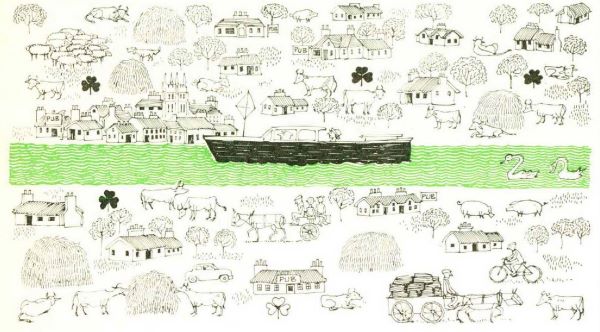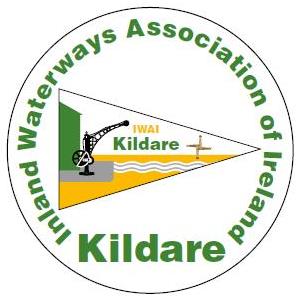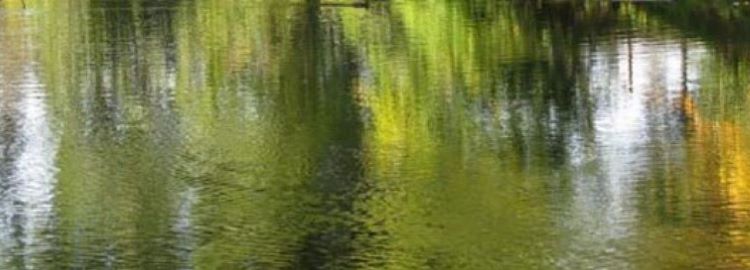Cows on the Quay – by Polly Redford – Atlantic – March 1965 issue
Cows are an integral part of the Irish yachting scene; at least they were last summer on the Grand Canal, where my husband and I hired a yacht for a week’s cruise through counties Kildare and Offaly, from Dublin to the Shannon and back. The Grand Canal is probably the only canal of its size in the world devoted to pleasure boating. It once had a more serious economic purpose, of course, but that was in the days before roads and railroads put small barges out of business and the fastest, grandest way to cross central Ireland was by boat.
There were passenger barges then, and a chain of canal hotels, docks, and warehouses, some of which can still be seen in various stages of ruination along the quays of Robertstown, Edenderry, Daingean, and Shannon Harbour towns that have retained an innocent flavour of the early nineteenth century, when they grew and briefly prospered.
Between the towns there is a landscape more innocent still. It is filled with cows: cows in the background dotted over hillsides, cows in the middle distance clustered around thatched-roof barns, cows close by, lying on the canal towpaths or gazing blandly at you as you rise, or fall, through the locks.

Rural Ireland © Polly Redford 1965
Rural Ireland is more rural than anywhere else. Its wild flowers and clover, peat bogs and hedgerows, water lilies, swans, swallows, warblers, and fragrant grasses are best seen from the deck of a slow, slow boat, for there are views of the world that simply do not come into focus at speeds over ten miles an hour. At six or seven miles an hour you rediscover senses lost in trains and planes and buses. You not only see the countryside, you smell it in wheat fields, honeysuckle, and peat fires; you hear it in unfamiliar songs of new birds, in the splash of a jumping fish; you can even feel it in a cool breath exhaled from the walls of a lock on a hot day. A trip on the Grand Canal takes you away from roads, straight through woods and fields that motorists never see.
Then, too, the simple necessities of shopping, housekeeping, and running a boat remove that heavy passivity which is the curse of tourism. Having something to do, you become, however briefly, a part of the landscape itself. This is why my husband and I like boat trips. We take them whenever possible because we have found that they bring us into a country as no guidebook can. So small a thing as stepping ashore for a kettle of water will lead you (as it did us one evening) across an old bridge, over a lichened stile, down a road past a woman in a weathered jaunting car, to a well which turned out to be a small pool hidden under hedges of blackberry and hazel.
Our boat, a beamy twenty-four-footer named Glen Imaal, we hired by mail from a bicycle company in Dublin. Originally built for English cruising on the Norfolk Broads, Glen Imaal drew only two feet of water and came complete with full berths, bedding, enclosed toilet, gas stove, kitchenware, dining table, dishes, plenty of stowage space, and a roomy cockpit with folding top that could be raised in wet weather.
Glen Imaal also carried a wireless set large enough for transatlantic passages, a totally Irish machine that hummed threateningly and dimmed the lights way down whenever we switched on the evening news. This in itself took care of most of the evening, since Radio Eireann reports exhaustively in the Irish language and one must wait half an hour for the English translation. The news was the only Irish we ever heard spoken in Ireland.
All of this — bedding, dishes, boat, Radio Eireann — was ours for thirty pounds a week. (The Irish pound equals $2.80.) We also paid another three pounds, twelve shillings in lock fees because there are twenty-four locks between Lucan, the Dublin suburb which is Glen Imaal’s home port, and the River Shannon, seventy-three miles to the west. These locks, unchanged in a century and a half, are made of roughhewn granite blocks and are closed at either end by a pair of heavy oaken gates. They are sixty feet long and thirteen feet wide: dimensions that ultimately ruined the Grand Canal by limiting the size of its vessels to unprofitably small barges. In 1956 commercial traffic virtually stopped, and vegetation began its slow sweet march over what had once been a considerable feat of engineering.
Theoretically, there is someone on duty at every lock during the summer months when yachtsmen cruise among the cows. In practice, many of the locks are self-service. For this purpose, Glen Imaal’s equipment included a large wrought-iron “key” resembling an oversize automobile crank and weighing some ten pounds or more. The key made us independent of all lockkeepers, for with it we could wind the sluice valves up and down ourselves.
On the Grand Canal everything is done by hand. Even the lock gates, massive as they are, have no machinery whatever but operate on simple leverage by means of long sweeps, which are solid oak beams, twenty inches thick, that stretch along the top of the gates and thirty feet on beyond the hinges. They almost reach the threshold of the lockkeeper’s cottage. Beginning there, the boatman (or the lockkeeper) opens half the gate by leaning his full weight on the beam and walking his end in a wide, slow semicircle toward the water. On the other side, his wife, more slowly and less majestically, opens her half.
In the lock itself one waits and watches the small flowers that grow in the gaps between the stone blocks, and as the water level falls, a riot of weeds and mosses comes into view. Unexpected jets of water arch from holes where the lock gates have rotted through; many of the sluice valves are jammed shut or have lost vital connecting rods. The lockkeepers’ houses, too, are falling into ruin. In fact, the whole Grand Canal is gently crumbling away. This impression is heightened by the many remains of castles and cottages, overgrown with ivy, which lend such a sweetly melancholy air to the whole countryside that one has the feeling of having floated backward in time and into one of those early Victorian engravings where sighing maidens and weeping willows lean out over the water.
But all is not early Victorian. Extraordinary towers rise in the distance: they are the Electricity Supply Board’s new generating stations that produce power from milled peat. And as we sailed through the bogs, we watched the peat-cutting machines, orange monsters that scrape a thin layer from the top of the bog, leaving behind them vast red-brown areas exposed to the sky. Making electricity from peat is one of those typically Hibernian combinations of old and new; it accounts for the latest Irish phenomenon, ancient cottages with television aerials sprouting from their thatched roofs.
At Tullamore, a large town as Irish towns go, we stopped for baths and provisions. Provisions were easy, for Tullamore boasts two supermarkets in addition to its cinema, modern school, and D. E. Williams Company, distillers of the famous Tullamore Dew. “Give Every Man His DEW!” is D. E. Williams’ slogan, prominently displayed about the town.
Baths, however, are another matter, as we discovered when we stopped at a large AA hotel. In Ireland it is easy to rent a room without a bath, but a bath without a room! In vain we explained our situation — small boat, no hot water, glad to pay. The clerk was young, and she knew immorality when she saw it. The manager? He was out. She herself could not possibly authorize anything like this. Finally an older employee intervened. With an experienced eye she took in our obviously married expressions, our odd clothes. I was wearing an old bird-watching jacket on which was sewn a shoulder patch displaying a large heron and the words Florida Audubon Society. It was the badge of respectability, and in Tullamore everyone gets his due. Seeing it, she gave us her blessing and extra heavy towels besides.
It was also in Tullamore that I stepped ashore one evening carrying Glen Imaal’s yellow plastic bucket. It was the hour of the dog, and I was after water. The sun sets late in Ireland in July, and at 9 P.M. there is still enough light to bring every man and woman who owns a dog out for a walk along the towpath. Seeing me with my bucket, several dog owners offered me advice on where to find the best water, all of it wrong. The tap by the handball court was dry; so was the one in the big building behind it. Providentially, the priest came out for an evening walk of his own. He proved to be the best source of water: the pump in the basement of the rectory, of course. Very kindly he went and drew me a bucketful.
Outside the rectory we stood and chatted a few minutes. The rectory itself turned out to be one of the canal hotels, built in 1812. The priest told me of his troubles with the heating and the roof.
“Every night before I get into bed, I kneel at the foot of it and say an extra prayer” — he rolled his eyes upward — “that the roof will still be over me head and not around it in the morning.”
He also told me a little of the canal’s history and how it had once brought prosperity to towns along the way. “Then the railroads came, and afterwards the highways and the lorries, and that was the end. When I first came to Tullamore, a few barges still served the textile mills here, but the whole thing was finally abandoned. Tullamore would like to see the canal kept open, for there’s no hurry about shipping textiles to Dublin and it’s good cheap transport.”
But if the Grand Canal is eventually restored, it will be for pleasure rather than for commerce. Boating brings tourists to Ireland, and the Irish Tourist Board estimates that by 1970 yachtsmen will be spending £250,000 a year on the River Shannon and its chain of six interconnecting lakes. These are the major cruising grounds; they are already so profitable that the government has scheduled £140,000 worth of improvements and publicity during the next five years. Boatmen argue that restoration of the Grand Canal should be part of these plans, as well as improvements on the River Barrow, which connects it with Waterford, eighty miles to the south. Between them, these two waterways add another two-hundred-odd miles of cruising to the pleasures of the Shannon. More important, they link the Shannon lakes with the Irish Sea — a great convenience to Dubliners and Englishmen, who constitute the great majority of Ireland’s boating public.
Unfortunately, our one-week hire period was not long enough to take us up the Shannon. My husband’s dead reckoning put Glen Imaal’s top speed with a good following wind and no weed on her propeller at a snappy six miles per hour. This estimate must have been fairly accurate, for one morning as we were steaming full speed through the Bog of Allen, an old man slowly pedalling an ancient bicycle along the towpath overtook us, passed us, and was soon out of sight. Other than this, counting locks and bridges was the only way to calculate our forward motion.
Pubs along the Grand Canal are small; some of them have dirt floors; most of them have a large coloured Sunday supplement photo of John and Jacqueline Kennedy on the wall. In them we found English boatmen who had passed us on the canal as they headed toward the annual Shannon boat rally at Athlone. A holiday spirit prevailed around the bar. I remember one man in particular, a corpulent fellow who hailed each new round with a cheery shout of “Here’s to your good health and to hell with the Common Market!”
Only when the British left would Irishmen begin to talk, slowly at first about the weather and prices, then about their American relatives; finally and inevitably they would point to Kennedy’s picture and ask about the assassination as if we might have had secret information that explained it. Somehow, they always spoke of him as if he had been President of Ireland, not the United States.
Between the pubs and the birds (whenever we saw a new bird, we threw the engine into reverse and rushed for our glasses and field guide), we were lucky to make Shannon Harbour. When we did, we found it a ghost town. Now derelict, its dry docks, warehouses, and large canal hotel testify to its former importance as terminus of the canal. Half-sunken barges lined all the quays but one, where several pleasure craft were moored and two barge hulls were being converted into houseboats. It was Saturday evening, and we tied up by the gutted hotel, whose basement now serves as a cow barn. Next morning we awoke to a country deserted. Sunday morning in rural Ireland! Everyone has gone to Mass; even the dogs disappear. It was so quiet we could hear church bells clear across the Shannon and, miles away, a bull bellowing.
One prosperous house stood near the docks. Before it was parked a sleek new car, a dark-green Jaguar, highly waxed and most out of place in Shannon Harbour. Around this wonder a flock of cows had gathered. They were licking it appreciatively. Was it the morning dew or the taste of wax? No Rolls-Royce was ever polished or caressed as lovingly. Their thick warm tongues flattened out over the fenders, curled around the chrome. Soon more cows appeared, and there was some pushing and shoving to see which one would dominate the choice areas around the trunk — until the outraged motorist rushed from the house. No Mass-goer he; the Sunday Independent was in his hands. He flapped it furiously in their faces. Anxious and confused, the cows blundered around the car a few moments, then retired to the basement and stared back through the ruined doorways with tragic eyes.
I watched them from the galley window while I did our breakfast dishes, and as I waited for the kettle to boil, a tide of optimism swept over me. There was hope for the future after all. Dreamily I pictured US 1 a century from now, when roads have been abandoned and everyone clatters around in smelly little rockets. The underpasses are flooded, the Howard Johnsons stand roofless and deserted, but in the summer months a few old crones still keep one or two gas pumps open for the benefit of tourists and sentimentalists who like to drive their handmade Edsels and Hupmobiles along the inner traffic lanes. The outer lanes are overgrown with wild flowers and patches of tender grass, inhabited by goats and geese which stray in from neighbouring farms, while the cows —
Ed: This and other pieces on waterways, barges and boats from 1857 to 2022, can be viewed at the Atlantic Back Issues Archive

